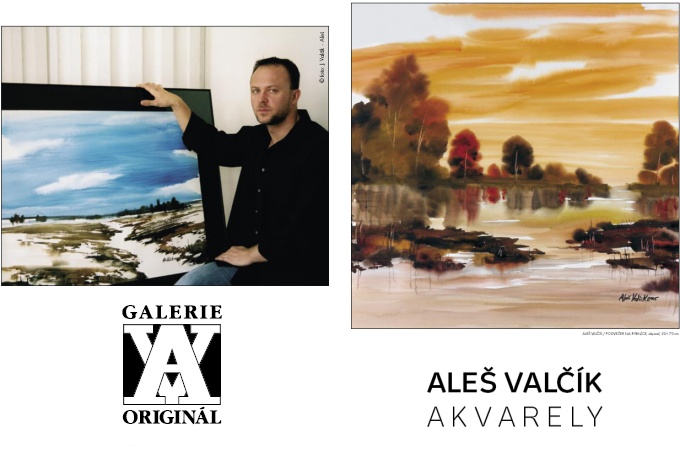|
Aleš Valčík
Aleš Valčík is the other member of Studio Valčík who focuses
exclusively on painting. Even though he joined the studio as a
trained photographer, he has remained loyal to the medium of
painting. In addition to the genres of the landscape, veduta and
seascape, Aleš Valčík cultivates rarer watercolor genres. We
might speculate about whether or not watercolors with their
tension between blurred and focused shapes are not close to the
original photographic picture. We might also search for common
photographic and painting elements hidden in the picture-postcard
nature of the veduta and seascape, but this would only lead to a
very vague understanding of the paintings presented by Studio
Valčík. In the beginning a moderated limiting of genre and
technique was characteristic for the studio. This homogeneity of
genre was later disrupted by the introduction of bouquets and
the occasional still-life, loyalty to technique remained. It was
if variability in terms of genre was the common denominator of
Studio Valčík and variability in terms of technique is the
differential element. We can however look even deeper. The
Valčíks vary in the type of landscapes they paint. While Josef
is renowned for his monochromatic and idealized landscapes and
Magda for her polychromatic, specific and universalized Moravian
and Bohemian landscapes, Aleš’s landscapes are just as colorful
as his sister’s but much more varied in terms of theme. He not
only paints local domestic scenes, but often ventures to exotic,
foreign locales as well as urban settings. In terms of technique,
Josef Valčík prefers a broader, more plastic brushstroke while
Magda is inclined to the polarity of small, pastose splotches
and broad swaths of color. In contrast, Aleš as a painter of
watercolors takes advantage of the contrast between transparent
or translucent colored spaces and the impenetrable shapes of
nature and civilization. In addition to color, light that shines
through the variable colored medium to the substrate also plays
an important role in his painting. This substrate is most often
white. Light reflects off it, sometimes remains captured or may
even be partly consumed and selectively reflected depending on
the character of the pigments used. The light may even form a
curtain, a covering that casts shadows of varying intensity. For
this reason the elements of water and air play a much more
important role in the paintings of Aleš than they do for his
father or sister. Not only are they best served by the
watercolor technique, they are contained within the medium
itself. This is also why his paintings have a low horizon,
meaning that the sky covers a large area. This is
counterbalanced by the large surfaces of lakes and the sea.
These two elements create a horizontal composition. These two
horizontal areas are linked by a variety of vertical forms: most
often trees and the stems of flowers but also ships’ masts and
chimneys. The varying, constantly changing qualities of the sky
and water surfaces is in contrast with the stable color
qualities of trees, houses and ships. The crowns of trees,
flowers and splotches on tree trunks are areas where the
horizontal and vertical come into contact, creating a
scintillating effect. Watercolors truly are somewhere between
painting and photography. While the photographic picture is
created by the physical effects of light that not only develops
the colors but is interned within them, the watercolor picture
is created by the physical effects of colored pigments and water.
Trails of light, which trails of color combine and rhythmically
amplify, are characteristic for this partly deliberate, painter-controlled
orchestration and partly accidental natural game. Perhaps it is
this intermediate position that most suits Aleš Valčík.
Professor Marian Zervan,
Ph.D. (b. 1952) is a theoretician and esthetician in the
fields of art and contemporary architecture. I is the author of
books of sacred iconography and as a curator has organized
exhibitions on Slovak architecture at home and abroad. He has
also written the catalogs for these exhibitions. He is an
assistant professor at both the Faculty of Architecture of the
Slovak Technical University in Bratislava and the College of
Fine Arts in Bratislava. |
